Saint Emilion rankings 2022: Is Grand Cru Classé accurately reflected?
Posted on September 29, 2022
By Panos Kakaviatos for wine-chronicles.com
29 September 2022
Following up on my text on the latest ranking of Saint Emilion wines – as published in Club Oenologique earlier this month – I focus on the total of 71 Grand Cru Classés, which is just shy of record from the 1969 classification of 72 wines so ranked.
Certainly many deserved promotion. For example, I couldn’t be happier to join a Champagne-infused celebration at Vignobles K’s Château Tour Saint Christophe, one of the 16 Grand Cru estates promoted to Grand Cru Classé. The estate is so well situated, with excellent terroir – as you can read here – and the team has worked very hard to raise quality so that the wines are consistently good, vintage in and vintage out.
Director Jean-Christophe Meyrou took aim at classification naysayers: “We hear a lot of bullshit about this classification, and of course it is not perfect, but which one is?” he asked rhetorically. “Which one requires a 10-year revisit?” Meyrou stresses that 80% of the criteria to be promoted to Grand Cru Classé is determined by a blind tasting of the last 10 vintages (50%), terroir quality (20%) and winegrowing and oenology (10%). Read More
Dry, small and challenging: 2022 Bordeaux should be (far) better than 2021
Posted on September 7, 2022

7 September 2022
By Panos Kakaviatos for wine-chronicles.com
Dear Readers,
Sorry for such a long absence. Because this site is free, I don’t update that often. I get paid to write for Decanter and other publications.
But here some Bordeaux 2022 perspectives, as I arrived the day before yesterday:
First off, the grapes are very small. “Yields will be catastrophic”, says Claude Rougier, of Château Camponac. Much of that is due to dry, hot weather, with little rain. Just walking along vines yesterday in Entre-Deux-Mers reveals compact bunches of small grapes, and among them raisin shriveled grapes. Read More
Bordeaux 2021 from barrel : the reds
Posted on May 27, 2022
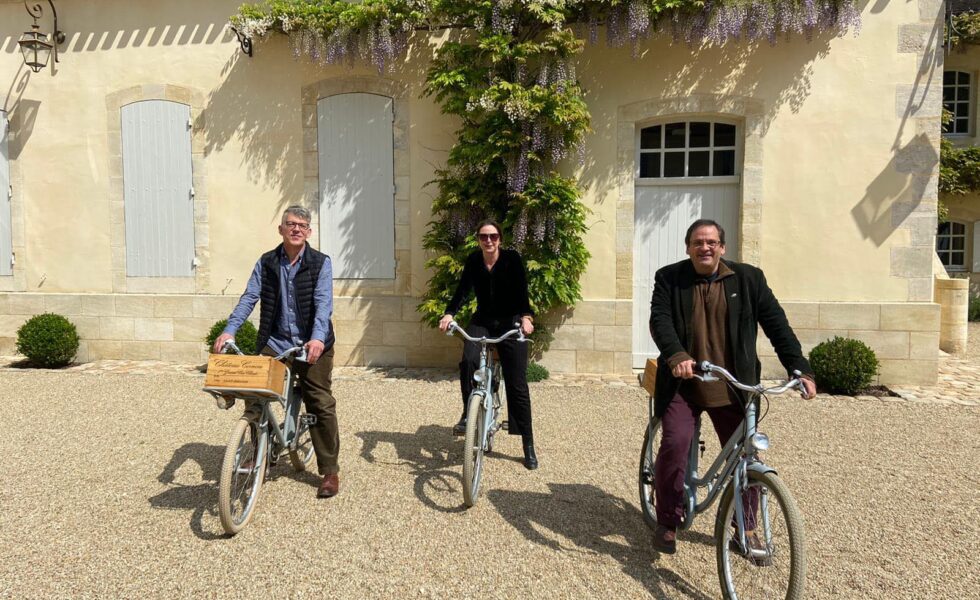
Bordeaux faces stalling futures campaign
By Panos Kakaviatos for wine-chronicles.com
27 May 2022
One of the last red barrel samples I tasted from Bordeaux’s 2021 vintage this year was on location at Château Gruaud Larose, in late May 2022, where CEO Nicolas Sinoquet explained how much hard work was needed to craft the best possible wine from the challenges of the vintage, over which you may have read in my earlier introduction.
Whatever we critics say about 2021, hats off to great efforts by estates committed to excellence, because we can write and assign a number, but that is but a trifle compared to months of stress from a stressful vintage.
As you follow new releases on Liv-ex, as well as comparative pricing analyses, several insiders told me in Bordeaux, that the futures campaign is stalling. With war in Europe, rising inflation and looming recession, who is buying an off vintage at prices (so far) too similar to 2020?
Having spoken to negociants, the sense is that Bordeaux would have done better to have said clearly that “Yes, we admit 2021 is an off vintage, but we propose a great discount, so try it for yourselves!”
Perhaps more buyers would be making orders? Instead, stocks are piling up, and many wines may well be sold only two years later at discount, if this trend continues.
As for the reds, sure, Bordeaux no longer makes bad wines, a common refrain from vintners in challenging vintages, but 2021 has a fair share of boring wines. So out of hundreds tasted from barrel, below my favorites, but even these would be better discounted by at least 20% over 2020, to better catch attention in a difficult market.
For tasting scores, ranges acknowledge sample variation, possible non-final blends, and it makes more sense to use a single score for a final bottled product for store shelves or delivery. I have been guilty of grade inflation in recent years, so ranges help insofar that the higher possible score reflects optimism. As usual, when in bold, I like especially. If red and bold, even more. And when underlined, too, approaching nirvana: Such wines tend to have the potential for 96 out of 100 points. An added asterisk*, up to (the rare) possible 97 🙂.
Right Bank: Côtes de Bordeaux and Fronsac, Pomerol (just below), Saint Emilion
Left Bank: Listrac/Médoc/Haut=Médoc/Moulis – Margaux – Saint Julien – Pauillac – Saint Estèphe – Graves/Pessac-Léognan
Bordeaux 2021 from barrel: the whites
Posted on May 13, 2022

Make Acidity Great Again
By Panos Kakaviatos for wine-chronicles.com
A quick reference to tasting notes below. I had published my reflections on the white wines of Bordeaux on 13 May, which I think shine most in 2021.
The reds are now online on a new page: HERE.
With thanks to estates that offered barrel samples to taste and to group tastings organised by the Grand Cercle, the UGCB, the Union des Crus Classés de Graves, the Conseil de Grands Crus Classés of 1855, Joanne and Pomerol Séduction among others. And thanks to dear friend and great Bordeaux author Jane Anson for the many tastings we did together.
As usual, wines in bold especially good. If red and bold, even better. If underlined, too, near nirvana. Click on the links below to get to tasting notes/summaries.
Intro text to 2021 vintage as tasted from barrel
Whites: Summary for the Whites – Graves/Pessac-Léognan – Bordeaux AOP dry whites – Sauternes/Barsac
Tasting Bordeaux from barrel in my 21st year in a row, the 2021 vintage was not frightening like Friday the 13th, when I first posted this review, but I heard a recurring refrain from many sur place: “Forget about recent vintages to understand 2021”. A civil way of saying that the vintage is not as good as 2020, 2019, 2018?
Well, yes.
Some stress that high acidity, combined with just ripe enough tannin and naturally low alcohol levels for many wines recall vintages from the “1990s”. “The vintage is not only good for whites, Panos”, admonished a distributor. He suggested “1997 or 1999”, as examples. But what about 1990, 1996 or 1998 (on the Right Bank)?
Others recall the 1980s, with high yields and few second (let alone “third”) wines. But iffy comparisons to explain the vintage ignore the fact that 2021 seems closer to the 1994 vintage of the 1990s for the tannin and acidity, rather than the more charming and soft 1999s (and 1997s).
As for the 1980s, 2021 is nothing like 1982, 1985 or 1989. Maybe 1988. Indeed, Olivier Berrouet at Petrus nodded approval when I mentioned that vintage for comparison.
2021 is not a great vintage for the reds, despite attempts to spin wonders over freshness, which, by the way, seems to forget recent spinning on how darn good global climate change has been for Bordeaux. 😉
I write for consumers, charging no fees to producers or to the trade for my work – and this is work. I love Bordeaux, but reviewing this vintage is meant to help buyers to better understand it. In that sense, I appreciated frank assessments from winery representatives like Frédéric Lospied of JF Moueix, which features excellent Pomerol and Saint Emilion wines.
Lospied dubs 2021 a “vintage for restaurants.” He explained that unlike many others, the JF Moueix estates neither added sugar nor bled vats for concentration. “We have been spoiled in recent years with far better conditions, so we cannot call this a great vintage”, he said.
Director Christian Moueix emphasized that no added sugar was needed, as “we prefer not to have to do that”, noting that 1984 was the last vintage when they chaptalised. Tasting the wines at Moueix reflected what was said: Some were better than others, but none reached the levels of excellence encountered in 2019 or 2020.
Olivier Berrouet, director at Petrus in Pomerol simply told me: “We are happy enough in 2021 to have made a good wine”.
2021 has some very good red wines, as tasted from barrel. A few even transcend the vintage, if …
If estates had great terroir for the vintage, if they diligently reacted to mildew in late spring and early summer (or if they did not have that problem), if they harvested late enough to capture as much ripeness as possible, if they were ruthless at sorting tables and if they carefully extracting tannin. That so many châteaux offered different explanations and strategies for fermentation and extraction indicates the needed hard work to make the best of things.
Most saw the need to add sugar for balance, and readers should not get the impression that this practice is something negative. Indeed, it had been rather common practice in Bordeaux until more recent “solar vintages” obviated sugar purchasing. But that changed last year: some estates couldn’t find sugar on the market and had to buy from other estates.
But was everyone “in practice” in adding sugar, after so many years of no need? Several winemakers told me that it was very important to “get it right” when adding sugar to vats in 2021. While tasting with Jane Anson of Inside Bordeaux, who has just released her impressions (worth subscribing), we noted some wines suggesting “awkwardly” added sugar: an attack initially fine, richness on the mid palate, but followed by somewhat astringent tannins and noticeable acidity: disjointed. Many chaptalized wines did not seem disjointed at all, so it came down to method. But seeing the need to do so yet again reflects the challenging nature of the vintage.
The Saint Estèphe exception?
Maybe not. Because excellent wines also exist on the Right Bank. But it seems the case for the Left Bank, because the northern Médoc, notably Saint Estèphe, saw less rain that most other regions in the late spring and summer, with little or no mildew issues. Even so: “This was not a solar vintage,” stresses Vincent Millet at Château Calon Ségur in Saint Estèphe, which crafted one of the best 2021 reds. So, if you are expecting vintages in line with 2018, 2019, 2020, indeed go to what has been said on location: don’t bother to compare.
Much analysis exists in my initial preview to the vintage for Club Oenologique, published on 22 April, which I encourage you to read, if you have not done so already. Here in Wine Chronicles, you get tasting notes for the wines I liked most.
In that Club Oenologique preview, I may have left the impression that 2021 was better for Cabernets, but that is not an obvious case. Yes, Merlots suffered more. Yes, Cabernets tended to benefit more from the long Indian summer, but you can find many rather successful Merlot-dominated wines on the Right Bank, so 2021 cannot be seen as either a “Left” or “Right” vintage, even if many estates tended to blend in less Merlots and more Cabernets.
Pricing
Indications as of this published writing (Friday 13 May) indicate that opening prices will not be that much different from opening prices in 2020 and may be higher than opening prices were for the 2019 vintage (the 2019s have since appreciated in value). Indeed, the opening price of Château Batailley is comparable to the current price of the 2020 vintage (source: Wine Searcher).
While inflation and supply chain issues are factors, given relative price parity between 2020 and 2021, the choice for most consumers for reds is obvious: go for the 2020, and/or other back vintages of quality, and wait for 2021 off-shelf prices, many of which likely will be discounted. I can envision 2021s in 2023 or early 2024 at the famous foire aux vins at massive supermarkets like LeClerc or Auchan in France, for example.
Exceptions exist, especially for enthusiastic fans of estates. Or for special editions. Take Haut Bailly and Figeac 2021 as examples: both have been crafted from inaugural, new (and impressive) cellars that have made the wines that much more precise. I would own some 2021 bottles from these estates, as these new cellars helped them do excellent work in 2021, with wines that transcend the vintage (they are not alone, as you will soon see in the reds tasting notes).
Other bottles to buy would be estates that you especially love, that did well in the vintage and that rarely charge exorbitant en primeur prices. If you are a big Château Batailley fan, for example, the price is no matter, as it has never been an investment wine. Such wines for me would include Domaine de Chevalier in both red and white from Pessac-Léognan, Clos du Clocher in Pomerol (let’s see the price), and Château Corbin and Château Tour Saint Christophe among a few others in Saint Emilion, and assorted reds from Saint Estèphe, and others. So, you can find happiness in reds.
However …
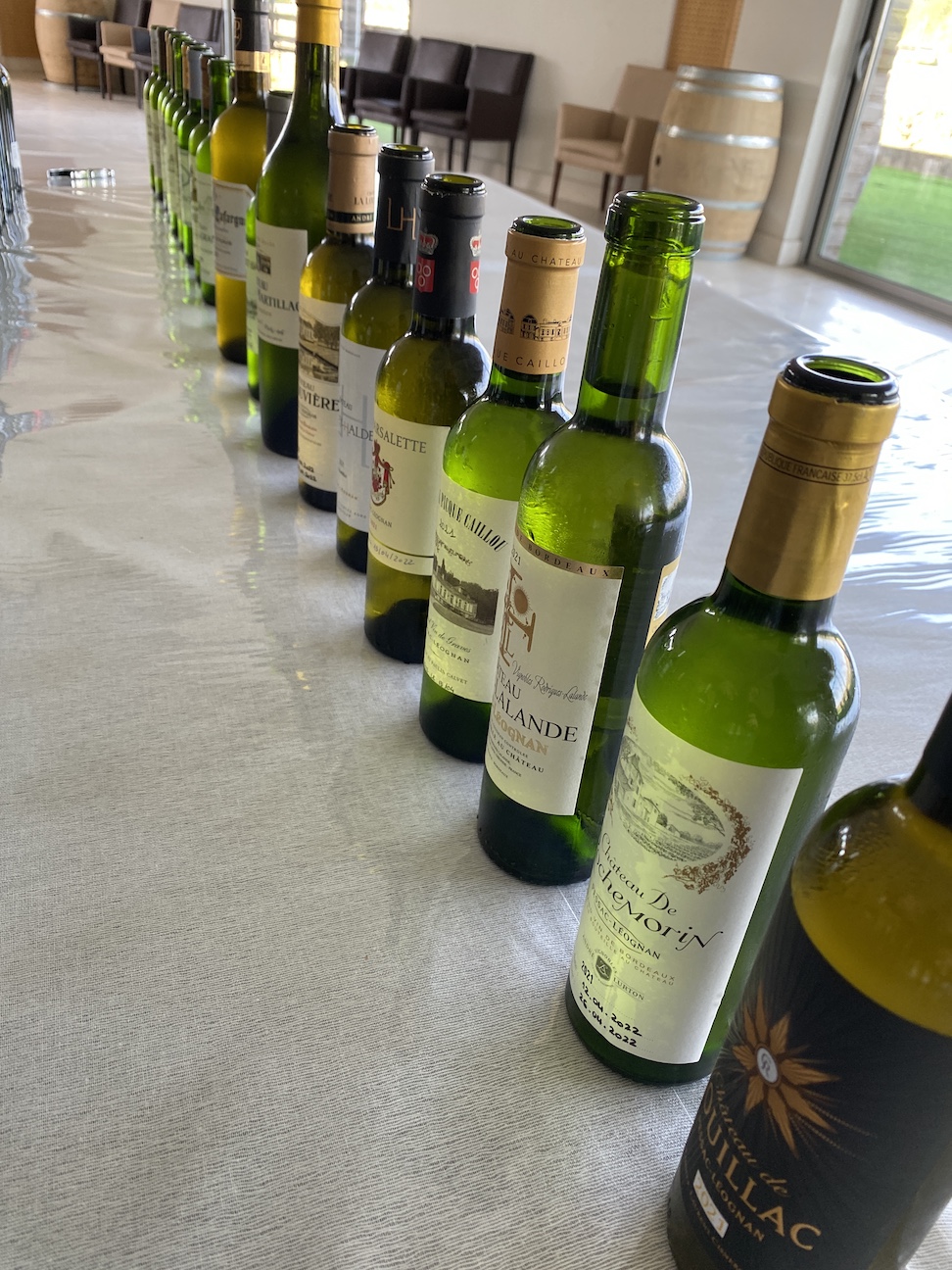
Tasting at the Union of Pessac-Léognan wines
I will start with whites because they shined more than reds in 2021, which happens not infrequently in Bordeaux.
In 1997, 2002, 2007, 2011, 2013 and 2017, the whites generally are better. 2008 and 2014 are tossups. Vintages like 2000, 2005, 2006, 2009, 2012, 2015, 2016 and 2018 favor the reds. Only rarely are both whites and reds excellent: 2001 and especially 2010 come to mind, although one could argue the case for 2019. In 2021, praise be unto the Bordeaux whites.
Tasting a barrel sample of Château Margaux was a very good experience, as one could expect, but the veritable ooh la la moment came with their dry white, as it did with the dry white at Château Lynch Bages. Or the dry white at Mouton Rothschild. The best whites of 2021 reflect not only clean, crisp fruit from the acidity of the vintage, but also palate density and dry extract, recalling the excellent 2017 vintage.
Do we risk over praising the dry whites in 2021? Are we drawing too much a contrast with many ho-hum reds in a vintage that Bordeaux expert and author Jane Anson has dubbed “largely mediocre”? That is a good question, which I answer with a cautious… “No”.
Sure, not all whites were great. Some exhibited over-steely acidities lacking mid-palate presence, albeit one can argue that barrel ageing would “fill them out”. Furthermore, it was not an easy vintage either for the whites, stresses winemaker Olivier Bernard at Domaine de Chevalier. Indeed, confirms Vignobles Lurton in Léognan, which reported that early April frost had reduced the potential harvest by 40% overall for their whites – with a 60% drop in yields at the excellent Château Couhins-Lurton. Significant rainfall in late spring and early summer caused mildew, too.
But small yields generally did not affect quality. As Bordeaux University experts Laurence Geny and Axel Marchal wrote in their report for the vintage, 2021 was “exceptional” for dry whites. They explain how cool summers – which are not so ideal for reds – are “generally conducive” to obtaining “great” dry white wines, as they “guarantee good acidity and preservation of aroma precursors”. 2021 follows that logic.
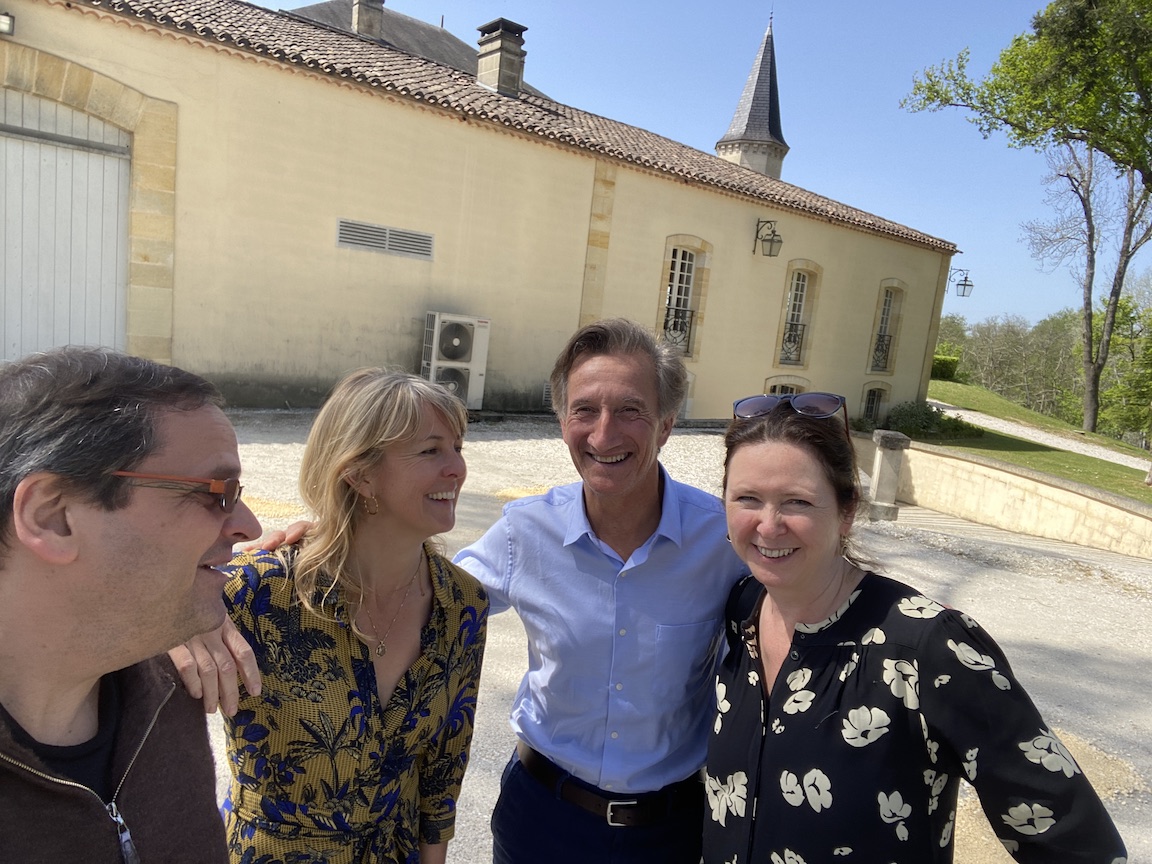
All smiles at Château Couhins-Lurton with Claire Dawson, Jacques Lurton and Jane Anson
For Marchal and Geny, Sauvignon Blancs in particular are “brilliant”. Despite high levels of malic acid, they are ripe, with a “chiselled profile” and intense aromatic expression, they report. On the other hand, Sémillons have “sometimes suffered”, on light soils, from a form of dilution, but on the best terroirs, they are slender, sapid and fragrant.
And the enthusiasm also comes from having positive examples across price points: from affordable Bordeaux AOC whites to pricier brands. Take for example the dry white of the Sauternes estate Château d’Arche. While the 2020 (excellent red vintage) was OK, the 2021 dry white exuded more vivacity and grip. In short: a better wine. So consumers can find excellent price/quality ratios from Bordeaux AOC wines, including those outlined in the tasting notes.
Finally, it is a good vintage to put the spotlight on whites for more market awareness. As Master of Wine Robin Kick remarked to me recently: “Most people at restaurants rarely if ever think of white when it comes to Bordeaux”. 2021 could change that. Restaurants, traders, importers and consumers will have reason to be excited about 2021 whites.
For late harvest whites, many suffered severe volume losses, but I tasted some amazing Sauternes and Barsacs, with pinpoint precision, bright fruit, and spicy, botrytis notes. For Sauternes and Barsac lovers, 2021 honors 2001, 20 years later.
Whites of Graves and Pessac-Léognan
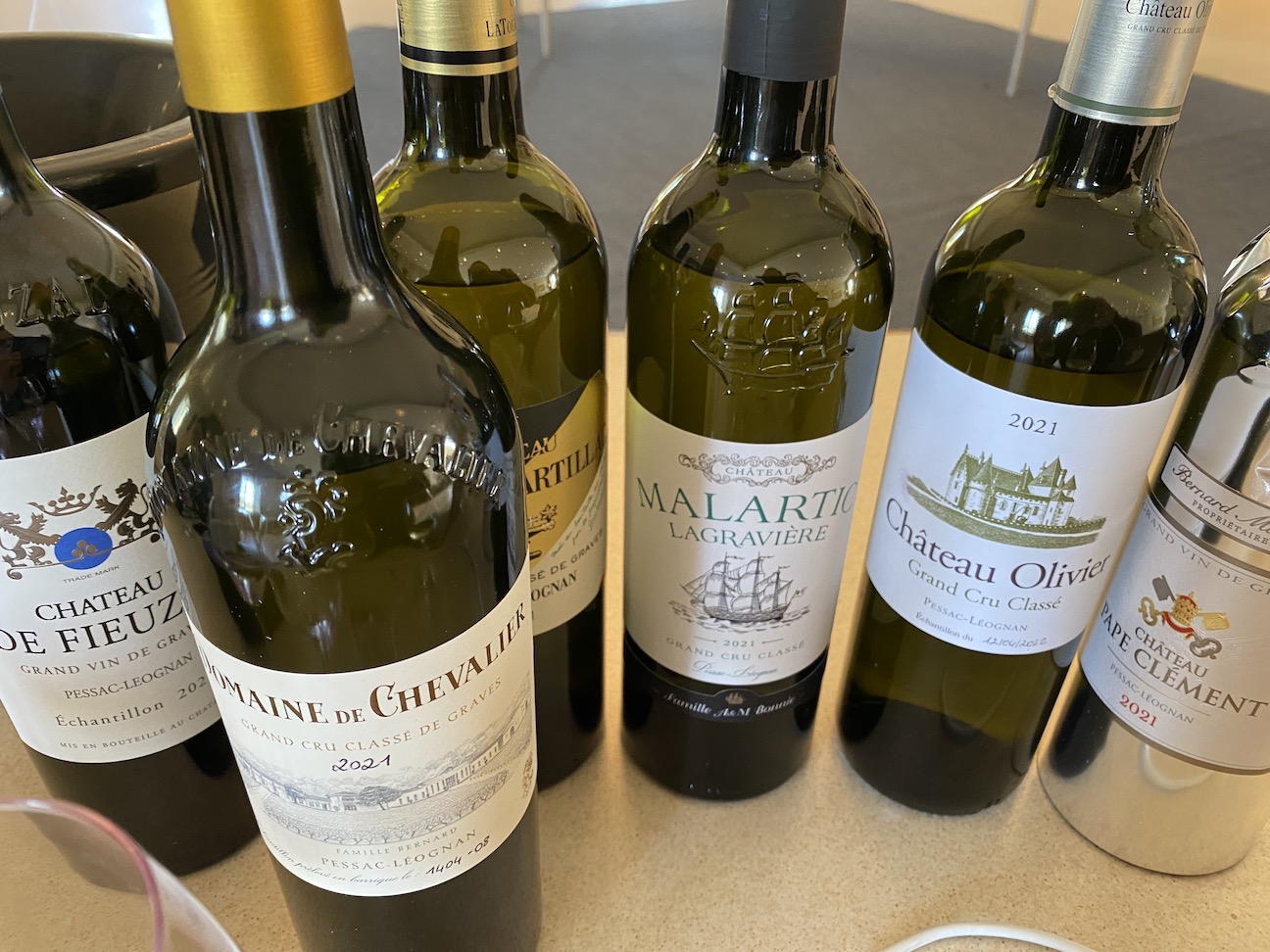
Shining stars of 2021
Château Bardins AOP Pessac-Léognan – Certified organic since 2019, this estate illustrates why not all dry whites are “amazing”, even given the contrast with the dry reds. While I like the crisp attack from what seems to be a blend of Sauvignon Blanc, Semillon and Muscadelle (unsure of percentage for each), the mid palate is slightly hollow and steely but let us see how from bottle after the 10 months ageing (with lees stirring). 13.5% alcohol. 89-91
Château Bouscaut Cru Classé de Graves AOP Pessac-Léognan – Clocking in at 13.3% alcohol and blending 70% Sémillon and 30% Sauvignon Blanc, this estate delivers smooth, ripe white stone fruit and clementine orange with juicy pear on the finish. A top white! With freshness and Sémillon fleshiness, it comes across just lovely. 94-96
Château Brondelle AOP Graves – Question mark for this blend of 50% each Sauvignon Blanc and Sémillon. At the Grand Cercle tasting, I was more impressed as the sample displayed salinity and roundness, with the perception that oak ageing would improve density (90-92). But tasted at the Maison de Graves, it showed steelier with gunflint reduction, which is fine. But while I also appreciated the freshness and fruit, the palate left me with a more foursquare impression. (87-89)
Château Brown AOC Pessac-Léognan – Obvious oak aroma and the wine a darker hue, but smooth texture – rather rich even – with white stone fruit, peach jam and lemon confit. A blend of 69% Sauvignon Blanc and 31% Sémillon. 90-92+
Chateau Carbonnieux Cru Classé de Graves AOP Pessac-Léognan – Fresh and frank, with quince and grapefruit aspects. A blend of 67% Sauvignon Blanc and 33% Sémillon, it comes across bright with juiciness, although one senses the acidity, somewhat trenchant. However, it should be more rounded/softened with 10 months of barrel ageing. Tasted three times (at Joanne, UGCB and the Union des Crus Classés de Graves) with similar notes. 92-93+
Clos Floridene AOP Graves – Love the peppermint and citrus aromas from this blend of 75% Sauvignon Blanc and 25% Sémillon, the proportion of which is rather high for this estate. The palate shows fine texture and energy, ageing in 25% new oak. Tasted twice (Joanne and Maison de Graves) with consistent notes. 90-92
Château Couhins Lurton Cru Classé de Graves AOP Pessac-Léognan – While not initially expressive, exciting quince and ripe yellow Kiwi, red apple and subtle herbal tones and spice emerge, accentuated on the well structured and fresh palate. The white vineyard of Château Couhins-Lurton was severely affected by frost: 60% losses to white wine volume. Such conditions led to “strong heterogeneity” in ripeness, so kudos to the team here to have successfully adapted by spreading pickings between 10 and 27 September. The sanitary state was monitored more closely during the summer, due to botrytis. In the end, the Sauvignons harvested (this is 100% Sauvignon Blanc) are of high quality indeed. Lovely! 94-96
Château de Cruzeau AOP Pessac-Léognan – Grapefruit rind and green melon from this 100% Sauvignon Blanc wine. Perhaps the palate seems a touch light, but with grip and verve. Ten months ageing in barrel should expand things. 90-92+
Château d’Eyran AOP Pessac-Léognan – This blend of two parts Sauvignon Blanc and one part Sémillon from a small 1.5-hectare vineyard exudes zesty grapefruit rind, and a rather sumptuous palate sense, albeit a touch of heat, which is unusual for the vintage. Ageing with lees stirring. 90-92
Clos Marsalette AOP Pessac-Léognan – An excellent dry white dominated by Sauvignon Blanc exuding pure, wet stone aromas leading to a palate with depth yet also conveying much elegance with oak tannin touches. Certainly would go well with seared scallops and a light cream sauce, with mushrooms. 93-95
Domaine de Chevalier Blanc Cru Classé de Graves AOP Pessac-Léognan – Tasted three times with similar results, this blend of 75% Sauvignon Blanc and 25% Sémillon exhibits amazing grip with a brisk sensation, yet a texture both nuanced and smooth. Ageing 18 months with 30% new oak, it should turn into a racy wine, as the acidities are “well managed”. Flavors/aromas include chamomile, jasmine, nectarine, kiwi, lemon peel, acacia and wet stone. Fresh and long, the wine benefits from deft oak ageing that lends density without being obvious. When tasted from barrel at the estate, owner Olivier Bernard explained care needed for winemakers in using new oak for Bordeaux whites according to the ripeness of the fruit and the level of acidity: “The more the acidity, the better the wine could stand up to new oak”, he explained. And 2021 is just such a vintage by which oak ageing would work well. With lees stirring, the wine comes across seamlessly integrated: Buy without hesitation, with special mention for an admirable second wine. 95-97
Château de Fieuzal Cru Classé de Graves AOP Pessac-Léognan – Once you get past the reduction from this blend of 65% Sauvignon Blanc and the rest Sémillon, you encounter pleasing white stone fruit and citrus, albeit not as complex or as dense as Domaine de Chevalier, tasted just beforehand. It is more good rather than spectacular, but I like the admirable freshness. 91-93+
Château de France AOP Pessac-Léognan – Success! The wine not only shows off vintage verve, but also displays density and weight, albeit with hints of alcohol, but not burly. A smoky sense, reduction perhaps, but not obvious and some intriguing slate emanate from this 80% Sauvignon and 20% Sémillon blend, ageing eight months (30% new oak). 92-94
Château Haut Selve AOP Graves – Delicious lemon meringue flavors delivered in a palate of impressive density without being heavy. This wine blends 75% Sémillon and 25% Sauvignon Blanc and although it finishes a bit tight, slightly sour, I think it will turn out nicely after barrel ageing. 89-91+
Château Larrivet Haut Brion AOP Pessac-Léognan – This blend of 78% Sauvignon Blanc and 22% Sémillon conveys a very pleasing touch hinting toast/brioche along with citron and baked pear aromas. The palate has density of oak tannin mingling with white stone fruit and yellow Kiwi and lemon meringue. Very nice indeed, as there is promising verve and structure. 92-94
Château Latour Martillac Cru Classé de Graves AOP Pessac-Léognan – Exciting grip with vibrancy! Tasted three times with consistent notes: Although not as subtle as the very top dry whites of the vintage, it more than delivers the goods with kiwi and green apple, more citrus than white stone fruit. The blend of 57% Sauvignon Blanc and 43% Sémillon conveys raciness and freshness on the long finish. 94-95
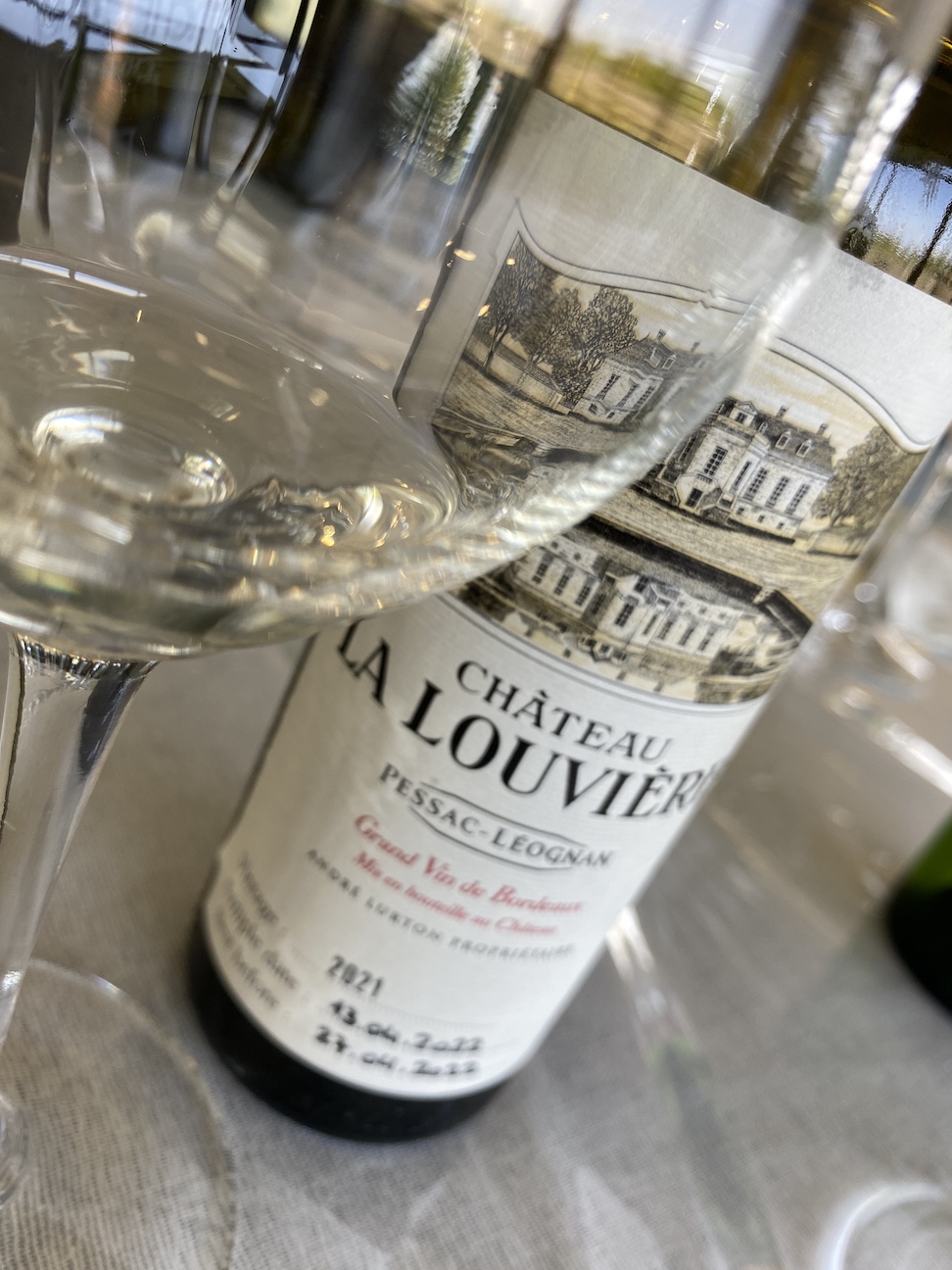
Price/quality ratio coup de cœur
Château La Louvière AOP Pessac-Léognan – A star among whites tasted at the Pessac-Léognan group tasting. This 100% Sauvignon Blanc has density and depth, nuanced texture with citrus and pear aspects. The acidity may seem a bit too “present” or “steely” at this early stage, but 10 months ageing in barrels – with lees stirring – will smoothen things. The bad news is small volumes (only 40% of normal volume), but excellent quality of Sauvignon Blanc at harvest time. Vinification in large 600L wooden barrels yields fine balance between oak and fruit. 92-94
Château Lespault-Martillac AOP Pessac-Léognan – For the price – a wine that sells for under €20 – you get fine density and medium plus body. While lacking the sheer excitement of some of the top dry whites, it has citrus freshness, blending 65% Sauvignon Blanc and 35% Sémillon. Tasted three times. 91-93
Château Luchey-Halde AOP Pessac-Léognan – Grapefruit rind, fun and a smooth texture are all positive signs for this blend of 60% Sauvignon Blanc, 30% Sémillon and 10% Sauvignon Gris, ageing 11 months with lees stirring. 91-92+
Mayne du Cros AOP Graves – Herbal tea, basswood and white stone fruit emanates from this impressive blend of 60% Sauvignon Blanc and 40% Sémillon, clocking in at 13.5% alcohol and ageing in 50% new oak. While not the longest of finishes, it is smooth and has fine density. 91-92+
Château Malartic Lagraviere Cru Classé de Graves AOP Pessac-Léognan – Tasted four times and very consistent: A great success from this blend of 89% Sauvignon Blanc and 11% Sémillon, revealing flinty stone and a somewhat reduced nose that bodes well for the long term. The palate? Fantastic density, akin to biting a juicy ideally ripe apricot. Qui plus est: You get a Burgundian feel. Long finish. Price should be friendly for the quality. 95-97
Château Olivier Cru Classé de Graves AOP Pessac-Léognan – Tasted three times (Joanne, Union of Cru Classés of Graves, UGCB) and with rather consistent notes of bright lemon and “herbal brightness” such as verveine and balsamic, along with subtle spice suggesting clove, but not pronounced. While I like the texture and density from this blend of 80% Sauvignon Blanc and 20% Sémillon, it lacks the length of some of the other top dry whites. Still, kudos to Château Olivier for having crafted fine red and white wines in 2021, even if not so surprising for the dry white. 92-94
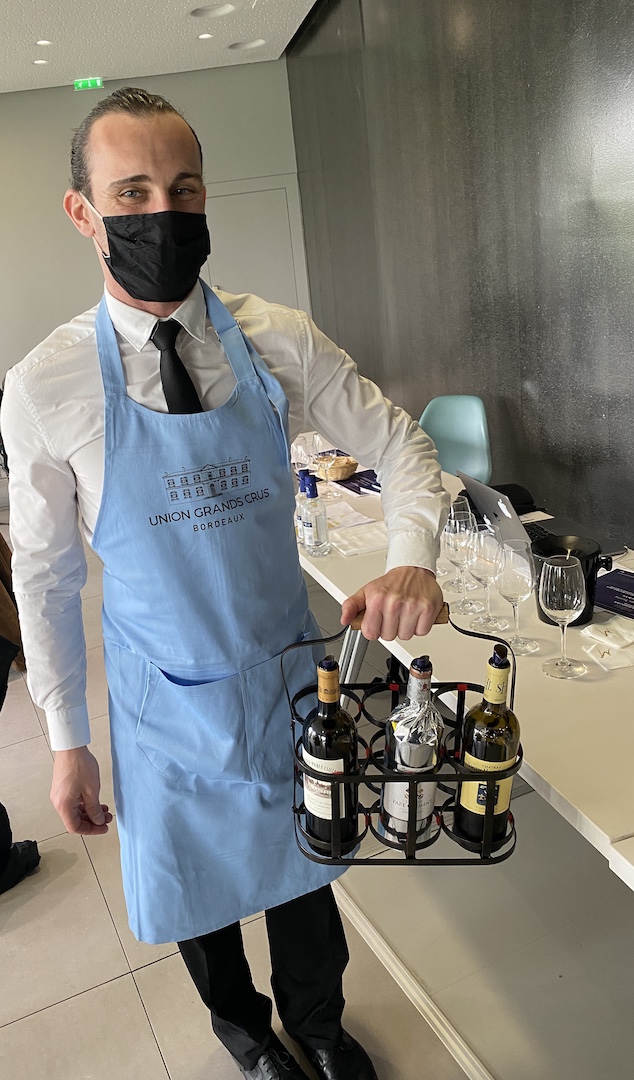
Bring on those whites: Excellent UGCB tasting in Bordeaux
Château Smith Haut Lafitte Cru Classé de Graves AOP Pessac-Léognan – Tasted on two occasions, including once as part of a vertical with other whites at the château, where it compared favorably with the 2019, for example (the vertical included wines ending with -9). Although initially soft, the nose deepens with time in glass to reveal both spring floral bouquet and white stone fruit, underpinned by a brisk line of grapefruit zest. The 50% new oak lends density to this blend of 90% Sauvignon Blanc and five per cent each of Sémillon and Sauvignon Gris. At the UGCB, I noted “superb white, on the level of Domaine de Chevalier, albeit a different style.” Indeed, the wine exuded “striking verve, focus and smoothness,” – and kudos to the Cathiards for joining other estates for group tastings: that shows confidence in your product. This is indeed an excellent white with a long finish. It will be interesting to compare with 2017 and 2014. 95-97
Château Pape Clement Cru Classé de Graves AOP Pessac-Léognan – This has thickness and power, well balanced by the acidity of the vintage, so you get an extra special Pape in line with 2014 and 2017. While tasting at the Union des Crus Classés de Graves, I found myself having more fun with the dry whites than with the reds, as they came across more vinous, more complete, more interesting. Anyhow, the texture here is smooth and more three-dimensional. 93-95
Château Picque Caillou AOP Pessac-Léognan – To be bottled in early June, this blend of 90% Sauvignon Blanc and the rest Sémillon conveys elegance with depth and a veritable suave palate. Cool freshness, and bright acidity – well handled – with lemon/lime excellence, but with subtle opulence on the mid palate. This has poise, clocking in at 12.7% alcohol and ageing in 25% new oak. 93-94+
Château de Rochemorin AOP Pessac-Léognan – Chamomile and lemon from this 100% Sauvignon Blanc, which has a delicate touch. It may lack the vigor of, say, Château Picque Caillou, tasted just before, and which I prefer, but Rochemorin is solid and with density. 91-92+
Chateau de Rolland AOP Graves – While not the most palate coating and longest on the finish, I like this wine’s vivacity and texture, with both precision and a smooth feel, with citrus and white stone fruit. A Graves worth buying to be sure! You can impress guests if you see it on a restaurant list. From vineyards in Barsac and organic since 2020 (or at least in conversion), this blend of 70% Sauvignon Blanc and 30% Sémillon was harvested by 10 September and has been aged six months with lees stirring (no new oak). 90-91
Château de Rouillac AOP Pessac-Léognan – Dominated by Sauvignon Blanc, although I do not have information on the final blend, this is another successful white, showing off a hint of nougat along with some wet stone. Fine salinity on the palate, nuanced texture… quite delicious actually, although it lacks the vigor of the Clos Marsalette, tasted just before. 91-93+
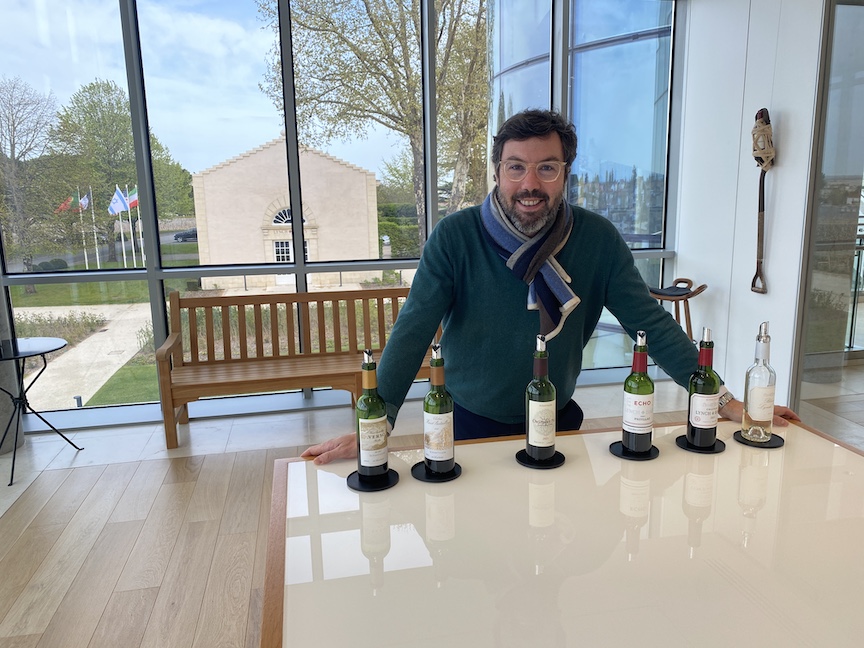
Jean-Charles Cazes at Château Lynch Bages
Ail d’Argent AOP Bordeaux (Château Mouton-Rothschild) – The wine had partial malolactic fermentation to soften acidity, which indicates that the vintage also posed challenges. This blend of 64% Sauvignons (both Gris and Blanc) and 36% Sémillon, ageing in 45% new oak, is very fine, chiselled and with notes of juicy yellow kiwi and acacia, delivered in a smooth texture. This excellent white has the dry extract and acidity to last, nicely reflecting the general success for the 2021 whites. The first vintage for Jean-Emmanuel Danjoy as director (for the entire growing season), after taking over from Philippe Dhaulluin. 94-96
Chardonneret de Château Peyredon Lagravette AOP Bordeaux – Coming from a Burgundy-shaped bottle, the blend I believe is about two parts Sauvignon Blanc and one part Sémillon, and shows off fine density, albeit a touch high-toned (noticeable acidity). The wine clocks in at 12% alcohol, and I am concerned over a lack of “baby fat”. But with ageing, it may turn out nicely, so I could be underestimated this. 89-91
Château Côte Montpezat Cuvée Compostelle AOP Bordeaux – Crisp freshness and lemon peel with notes of chalkiness. Not sure about the blend or alcohol, but a nice job here, coming from an estate in Castillon on the Right Bank. 90-92+
Château Fleur Haut Gaussens Projet Pierre Blanche 100% Sauvignon Blanc – Mint aspect with orange rind freshness and some lime. They must have done skin contact or some lees stirring as there is fleshiness to the wine. Salty finish. Fine. Very good acidity. 90-92+
Blanc de Réaut AOP Bordeaux – I have tasted this wine often at Planet Bordeaux for Decanter over the years and it succeeds nicely in 2021, tasted at the Grand Cercle. It has a reductive nose, but a “chipper” medium-bodied palate, with creaminess coming from fermentation in new oak. This 100% Sauvignon Blanc clocks in at 12.5% alcohol. 90-91
Château Reynon A0P Bordeaux – This 100% Sauvignon Blanc – inexpensive for under €8 – comes across straightforward citrusy with vibrancy. Tasted twice, at Grand Cercle and Joanne, with similar results. 89-90
Blanc de Lynch Bages AOP Bordeaux – This blend of 79% Sauvignon Blanc, 15% Sémillon and 6% Muscadelle seamlessly integrates the 50% new oak for ageing, yielding freshness and showy citrus aspects. A frank success, as the finish is long with lift. Bravo! 93-95
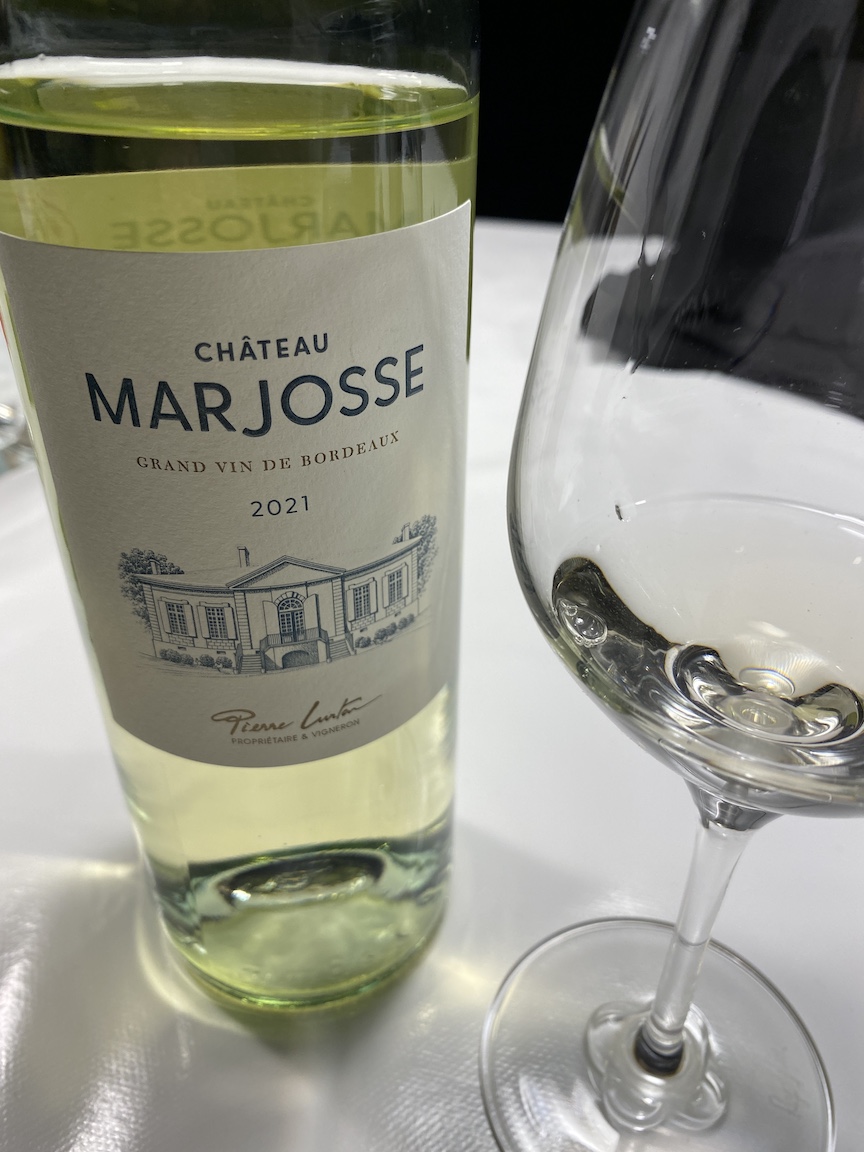
No need to spend big money on high quality Bordeaux whites. Here an excellent example.
Château Marjosse AOP Bordeaux – This 100% Sémillon combines impressive full body with a fresh salinity. At well under €10 a bottle, I would buy a case or two to serve at a garden party or with an opening course over dinner. This is lovely wine, which illustrates the potential excellence of the vintage for white Bordeaux. 92-94+
Clos des Lunes AOP Bordeaux – This is another excellent dry white, blending 70% Sémillon and 30% Sauvignon Blanc, from soils in Sauternes including limestone that lends depth and freshness. The 2021 has opulence for the vintage and the finish has lift and iodine freshness. 91-93+
Caillou Blanc du Château Talbot AOP Bordeaux – This blend of 80% Sauvignon Blanc and 20% Sémillon comes across fresh and smooth, and for a price of under €25, it would grace fine dining. Has well managed acidity and enough “baby fat” to last for about a decade, but will be enjoyable off the shelf later this year. 91-93+
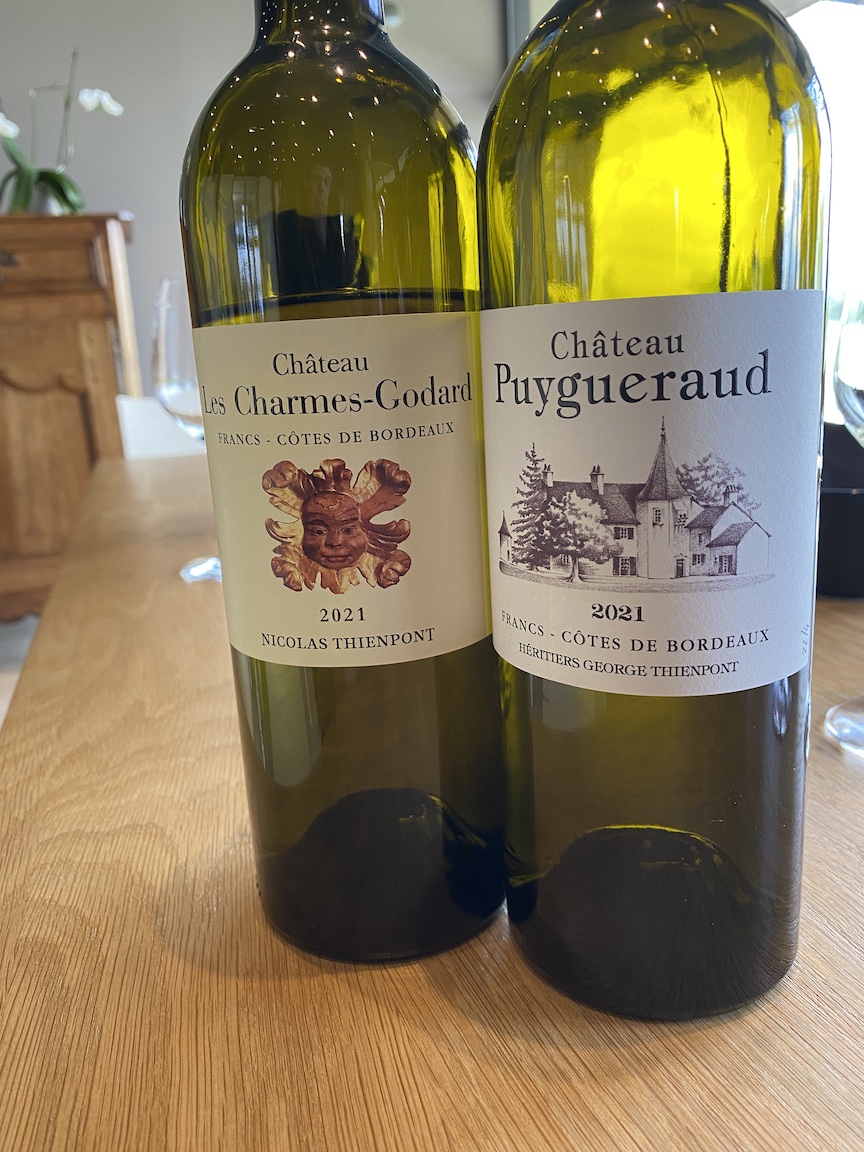
A nice pair of whites tasted at Château Pavie-Macquin in Saint Emilion
Château Les Charmes-Godard AOP Bordeaux – A showstopper, the careful – and later – picking of 65% Sémillon, 20% Sauvignon Blanc and the rest Sauvignon Gris resulted in density and Burgundian finesse. “We had to pick late because otherwise the wine would have been too green”, stressed Cyril Thienpont at Château Pavie Macquin. More good news: yields were quite high, at 48 hectoliters per hectare. I am buying this, and you should, too. 92-94+
Exuberance Blanc of Château Séraphine AOP Bordeaux – Another revelation among dry whites tasted but limited production from the same estate in Pomerol, this old vine Sémillon was crafted with plenty of lees stirring and ends up with such fine iodine freshness and density that you’d think you were in Burgundy. I tasted it in the mid afternoon, after it had been open since 6 pm the evening before, and it was as fresh as a daisy. Excellent! 92-94
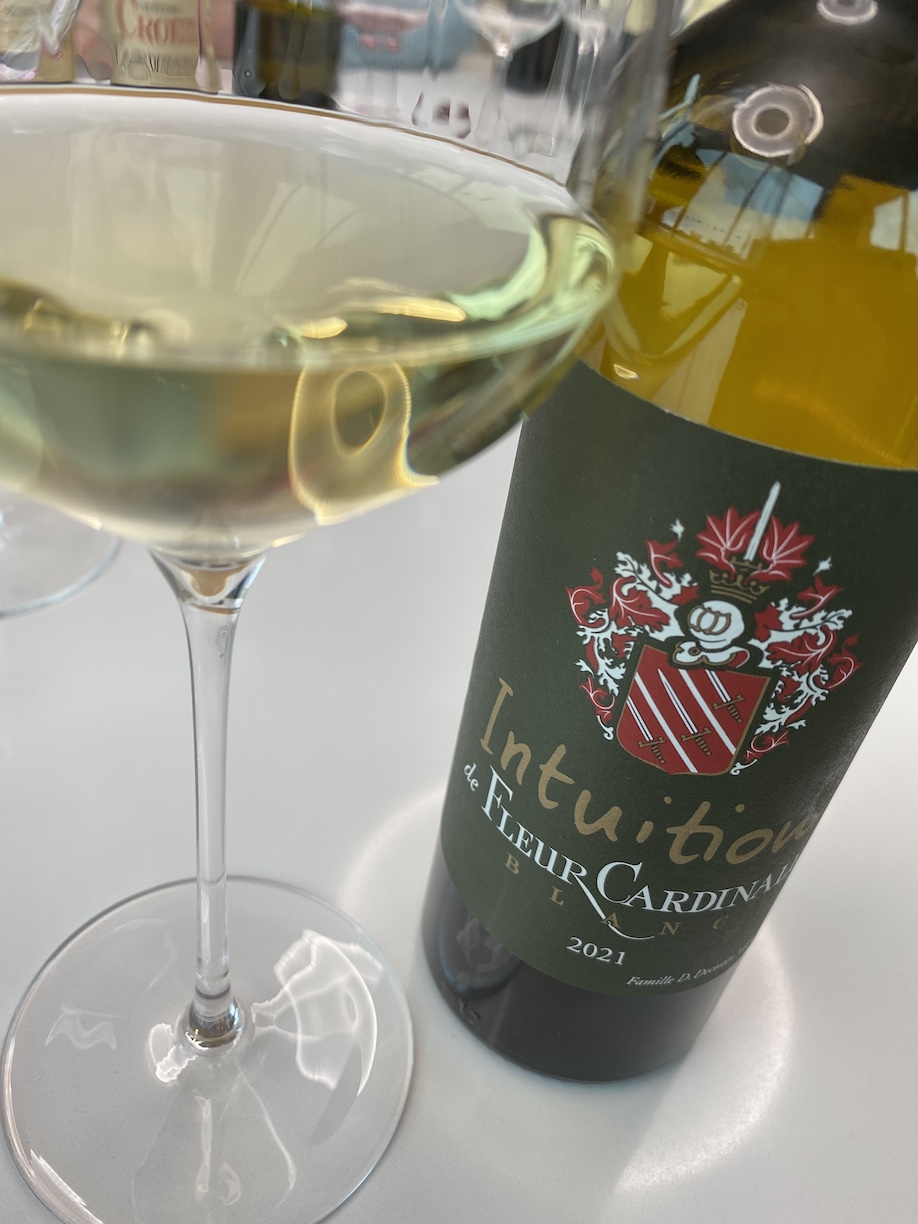
The team at Château Fleur Cardinale picked an excellent vintage to debut their dry white.
Intuition de Fleur Cardinale AOP Bordeaux – The inaugural vintage and a great way to start with this excellent white. Made from 50% Sauvignon Blanc and 25% each of Sauvignon Blanc and Sauvignon Gris, the wine is rounded and smooth without being heavy. Indeed, it imparts excellent density and energy, leaving the impression of sophistication. Fermented in non new Burgundy barrels, with lees stirring. Great white to get! 92-94+
Lions de Suduiraut Blanc Sec AOP Bordeaux – Limited quantities, about 32,000 bottles, and I am a buyer: this blend of 52% Sémillon and 48% Sauvignon Blanc is gorgeous. Why? It conveys both vivacity and density, with a creamy texture leading to a bright and exciting long finish. If you want proof of the potential greatness for white Bordeaux in 2021, look no further. The wine clocks in at 13.5% alcohol, aged six months in 25% new oak. 95-97
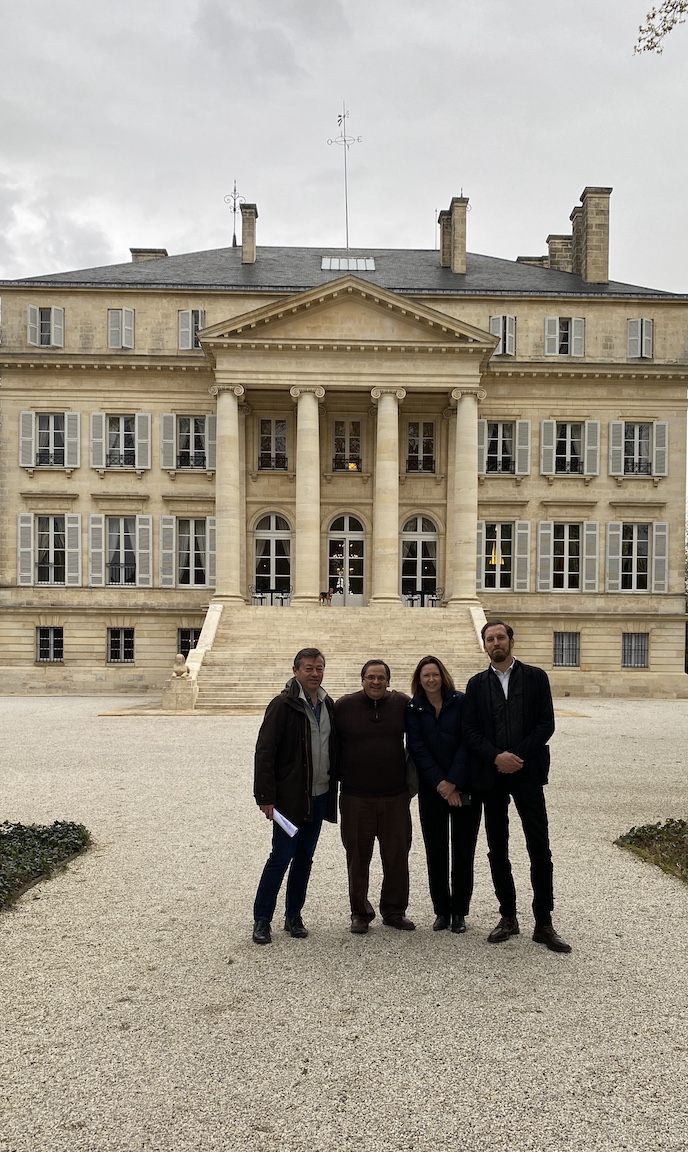
You should know that Château Margaux makes exceptional dry white, too. With director Philippe Bascaules and Jane and Francis Anson
Château Margaux Blanc AOP Bordeaux – What vivid focus! An exemplary wine of elegance and depth, the 100% Sauvignon Blanc stands up to the best white vintages from this esteemed First Growth, including 2014 and 2017. Picked between 7 and 13 September, the wine conveys quince, white stone fruit (juicy pear), subtle lemon peel and intriguing smoky aspects that season the wine. A very long finish, to boot. “We have density and power, and I am wondering if it is better than the 2017”, said director Philippe Bascaules. I would love to compare both in a vertical. 95-97
Château Puygueraud AOP Bordeaux – Finesse and bright notes of citrus and wet stone, and hints of tropical fruit (harvesting ended on 27 September). Tasted twice with similar results, this ninth release from the right bank estate blends 64% Sauvignon Blanc (a clone from the Loire that is nicely adapted to the limestone soils) and 36% Sauvignon Gris, although some vines were not used because of frost. This is a very good dry white for rather small change (under €10 a bottle). 90-92
Château Thieuley AOP Bordeaux – For about €5 you get a tasty, frank and fine medium-bodied dry white, blending 50% Sauvignon Blanc, 35% Sémillon and a touch of Muscadelle. 88-90
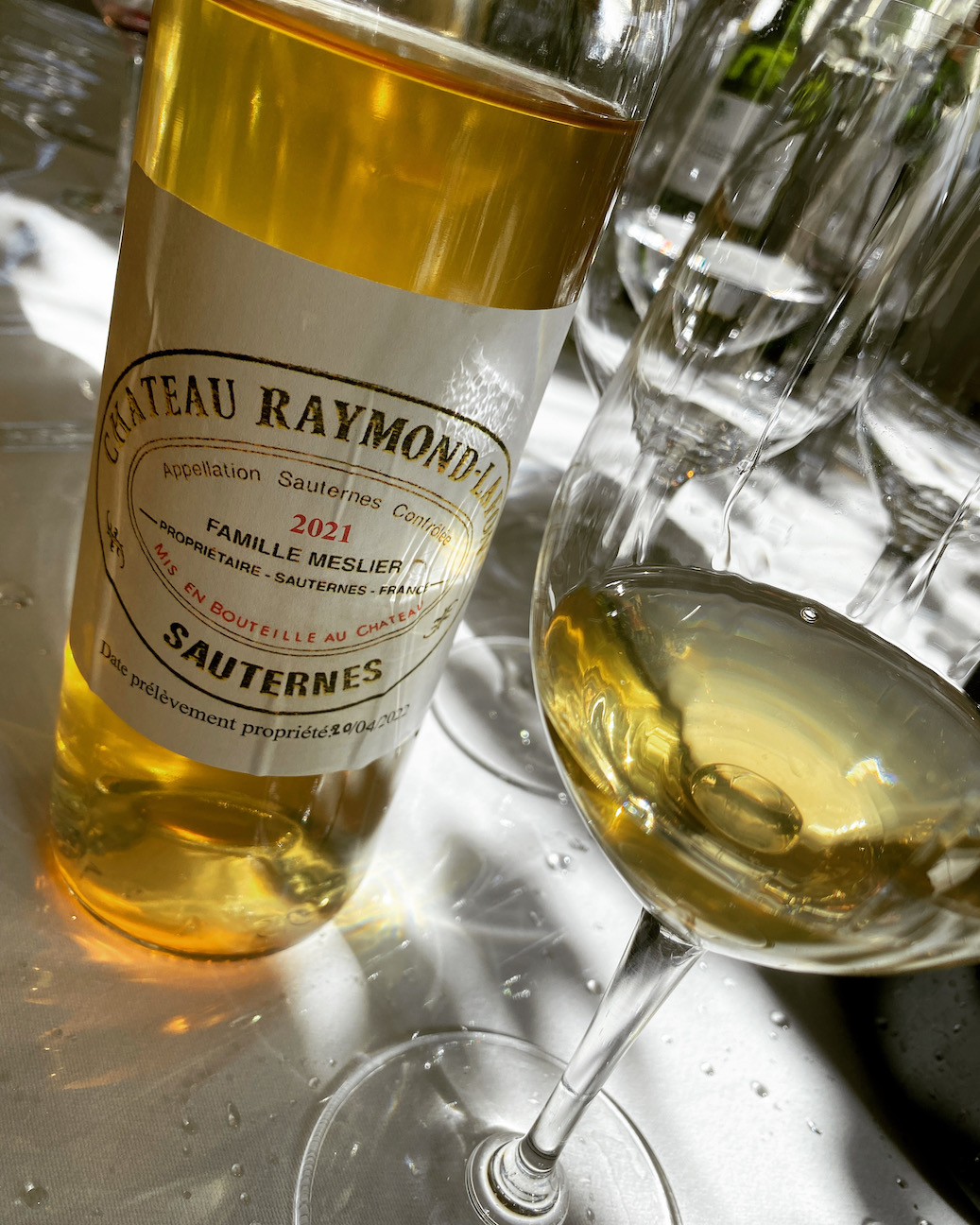
More bang for your Sauternes buck
Château Bastor Lamontagne Sauternes – Pleasingly in the mold of La Tour Blanche, but lacking the same vigor and verve. While exuding fine expressions of peach cobbler and juicy ripe pear, it comes across just a tad flabby by comparison. But it costs less… 🙂 91-93+
Château Clos Haut Peyraguey Sauterrnes Premier Cru Classé – Somewhat cloying aspect on the attack, but overall, I can see how this would please with cinnamon spice, ginger and white pepper – indeed very expressive! If just a tad too thick. Maybe I am misjudging as the wine will gain poise over time? Certainly the acidity is present. Let’s see. 93-94+
Château Coutet Barsac Premier Cru Classé – Lovely spice and superb density: An excellent wine! It has elegance, too, but it really excels for mid palate concentration. 94-95+
Château Doisy Daene Barsac Deuxième Cru Classé – Wonderful life and elegance as one could expect from Barsac. This has elegance and refinement too. Apricot, pear, hint of bergamot tea. Lovely stuff even if La Tour Blanche gets my nod on overall balance, if you want a more upfront late harvest style. 94-95+
Château Raymond-Lafon Sauternes – A gorgeous wine on the level of Tour Blanche, showing off superb energy and focus, exuding ginger, pepper, apricot, nectarine and smoky aspects. An estate near and dear to me, as I had worked there back in 2001, and I know the family, but no bias is factored here. The 2021 is a wine to buy without hesitation! 95-97
Château Sigalas Rabaud Sauternes Premier Cru Classé – Cool spearmint aspects with some concentration and energy, but outclassed by some of the better premiers. 90-92
Château Suduiraut Sauternes Premier Cru Classé – An amazing wine, this 100% Sémillon ageing in 50% new oak. It gives off such distinct notes of ginger and white pepper, with a sensually dense palate texture, evoking peach and pear. Very low yields, low production, but magical. A long finish. 96-98
Château La Tour Blanche Sauternes Premier Cru Classé – Tasted on three occasions with similar notes, this is terrific! The wine exhibits tropical fruit, quince and pineapple (but not from a can). A gorgeous palate, smooth and bright, furthermore with a light color that reflects that brightness visually. Along with Raymond-Lafon, a top flight Sauternes that will not hurt your wallet. 95-97
Perfect Champagne Day in Reims
Posted on March 27, 2022
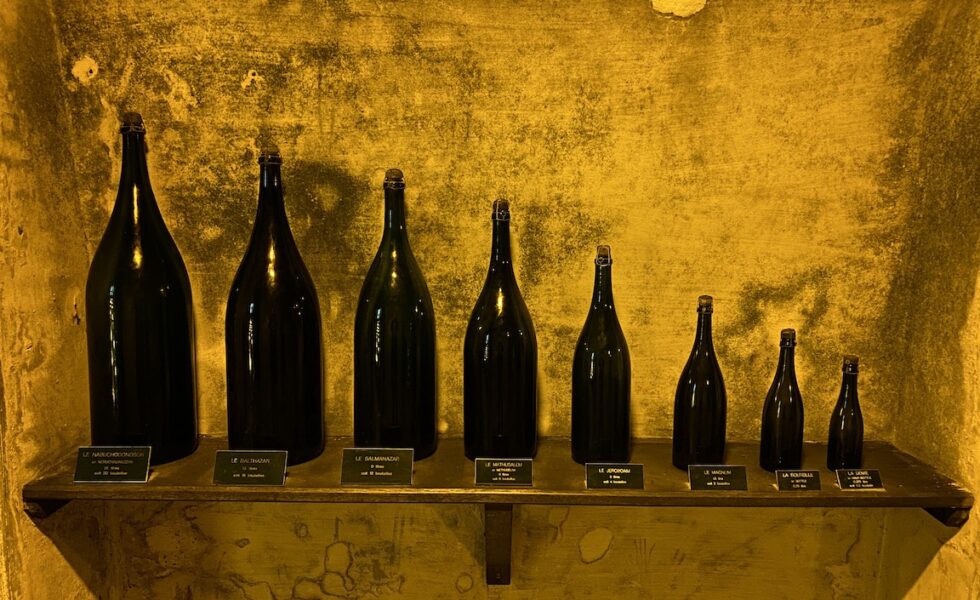
By Panos Kakaviatos
27 March 2022
UNESCO World Heritage sites include two in Reims: the Notre Dame cathedral, inscribed together with the Palace of Tau and the Saint Remi Abbey in 1991, and “Champagne Hillsides, Houses and Cellars” in 2015.
A majestic example of Gothic architecture, the 13th century Reims Notre Dame impresses with stained-glass windows and statues, including the iconic Smiling Angel. Indeed, Reims is known as “Coronation City”, as the cathedral hosted the baptism of Clovis around 500 AD and no less than 25 coronations of French kings.
As impressive as the Notre Dame is, my day focused on Champagne. The UNESCO World Heritage Site “Champagne Hillsides, Houses and Cellars” includes the Colline Saint-Nicaise, located on the southeast edge of Reims. Occupied by Champagne Houses since the late 18th century, the hill offered producers needed space to develop their businesses and – more famously – ideal wine storage in the form of the crayères, which were once chalk quarries. Branded “underground cathedrals”, they are a must to see, which I did in a recent visit to the celebrated Taittinger.
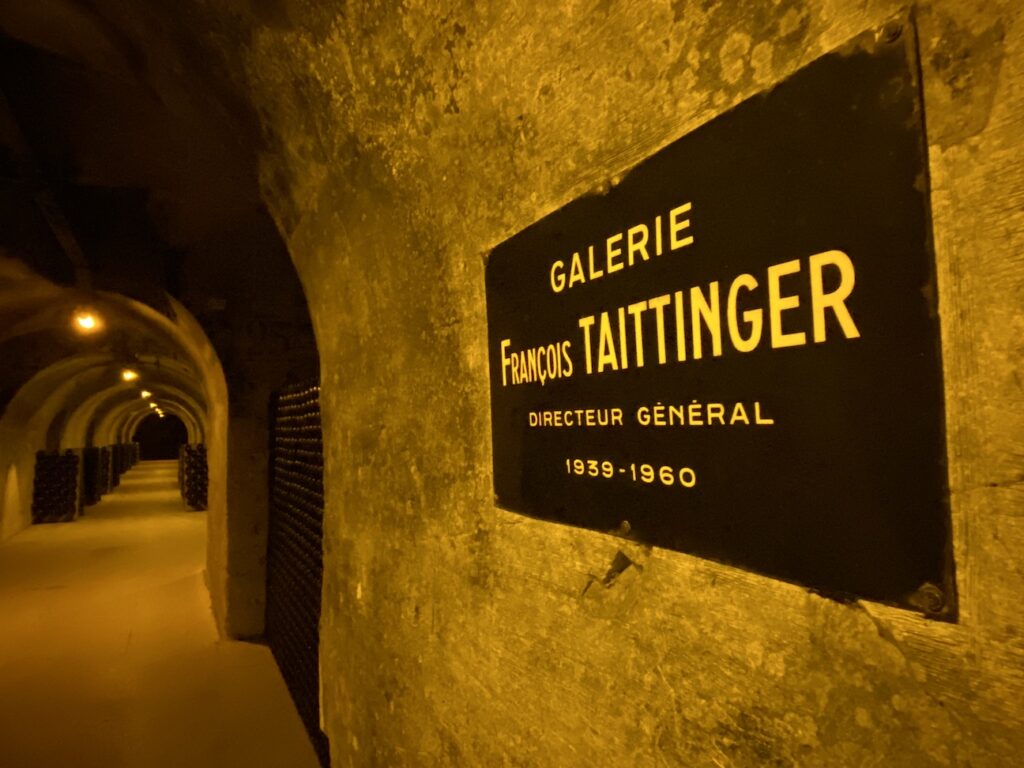
Underground treasures
Sixty feet underground, 52°F year-round with 80% humidity, the Taittinger cellars are ideal for wine. While admiring Methuselah six-liter sized bottles – each equal to eight regularly sized Champagne bottles – my guide explained that the chalk holds up to 50% of its weight in water. Readers may have heard how soldiers fighting in World War I found refuge here, leaving behind drawings, graffiti and initials scratched on the chalk walls. Underground telephone lines can be seen as well. And amongst the seemingly endless carefully piled rows of Champagne, a rare burst bottle, reminding you why Champagne bottles must be thicker than other wine bottles: to withstand in-bottle fermentations.
 Wine Chronicles
Wine Chronicles
Recent Comments